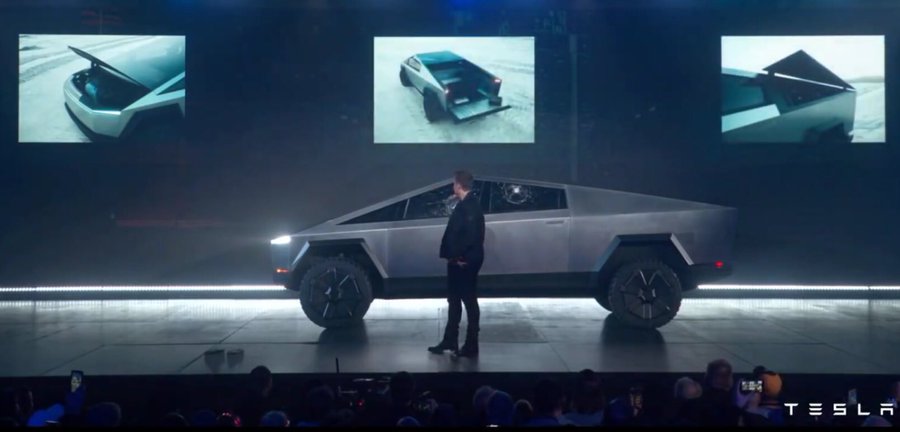
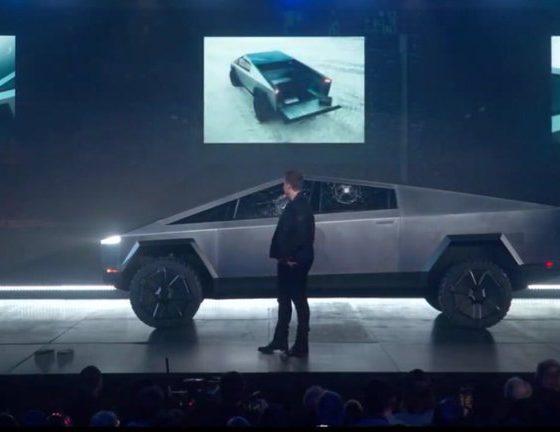
News
Tesla on hold as Texas court debates Cybertruck factory impact on taxpayers
Texas county officials where Tesla is seriously considering a Cybertruck factory are still debating over an incentive package to help bring the electric carmaker to the Lone Star State.
After two nights of discussion on the pros and cons of the move, the Travis County Commissioners Court has again postponed a vote on the matter to a date next week; however, from the recent comments, it’s clear that while many local executives and business leaders are optimistic about the economic benefits of Tesla’s presence, they have concerns about taxpayers and worker benefits.
During the Court’s session on July 7th, itself a continuation of a discussion on the matter in the prior week, several community call-ins indicated a wariness towards large employers that may not have the local taxpayers and employees’ best interest at heart.
“We are enthusiastic about companies that would like to come and take advantage of our vibrant culture and economy. With regard to Tesla, we’d like to affirm they are welcome, and that as long as they are spending their own money they are welcome to come on their own terms. If, however, they want local taxpayers to help pay for their move, the county needs to hold Tesla accountable to the same standards that it holds itself accountable to. In particular…a livable minimum wage,” commented Michael Floyd, a leader within the All Saints’ Episcopal Church in central Texas.
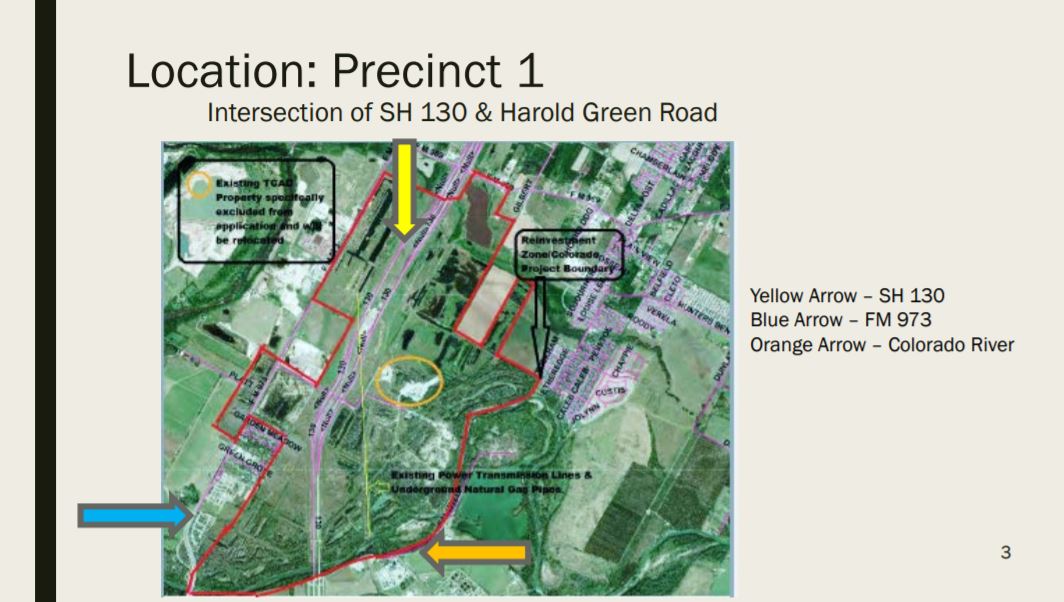
Jessica Wolff, deputy policy director for Workers Defense Project added, “Tesla has said that they will provide 5,000 middle skilled jobs. Our community needs more transparency. We need specifics. What types of jobs? How many will be temporary vs. permanent? What are the starting wages and benefits each will receive?”
Notably, Tesla seems to have provided fairly specific wage and benefit information in a presentation considered by the Travis County Court on June 23rd this year. Tesla’s impact on the Reno, Nevada community surrounding Gigafactory 1 could also be a positive testament to the carmaker’s potential benefit to Texas.
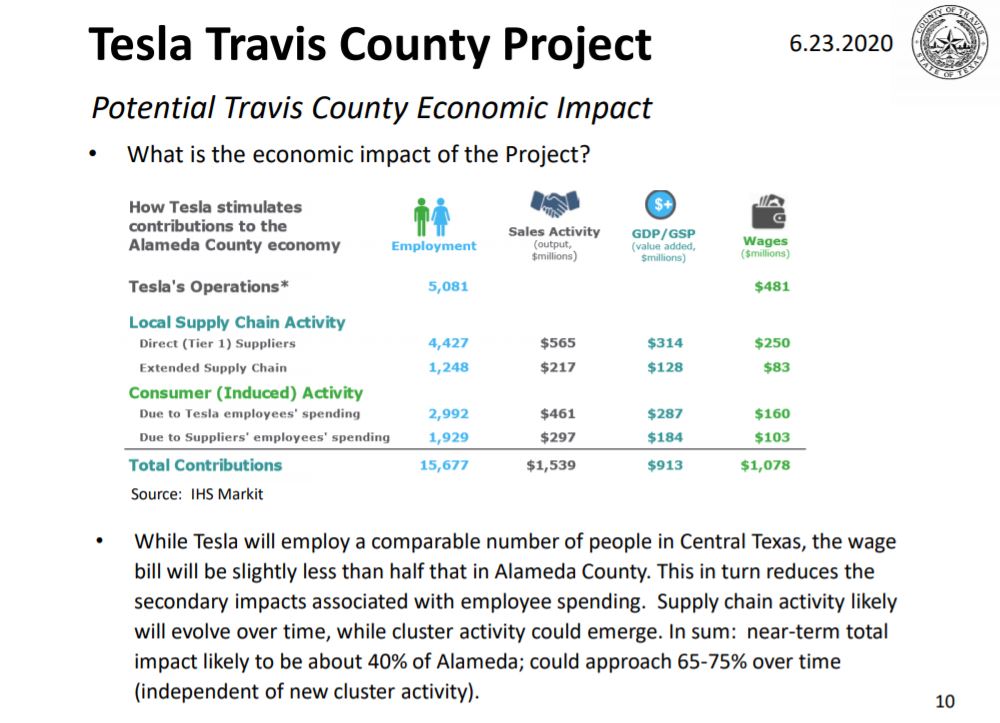
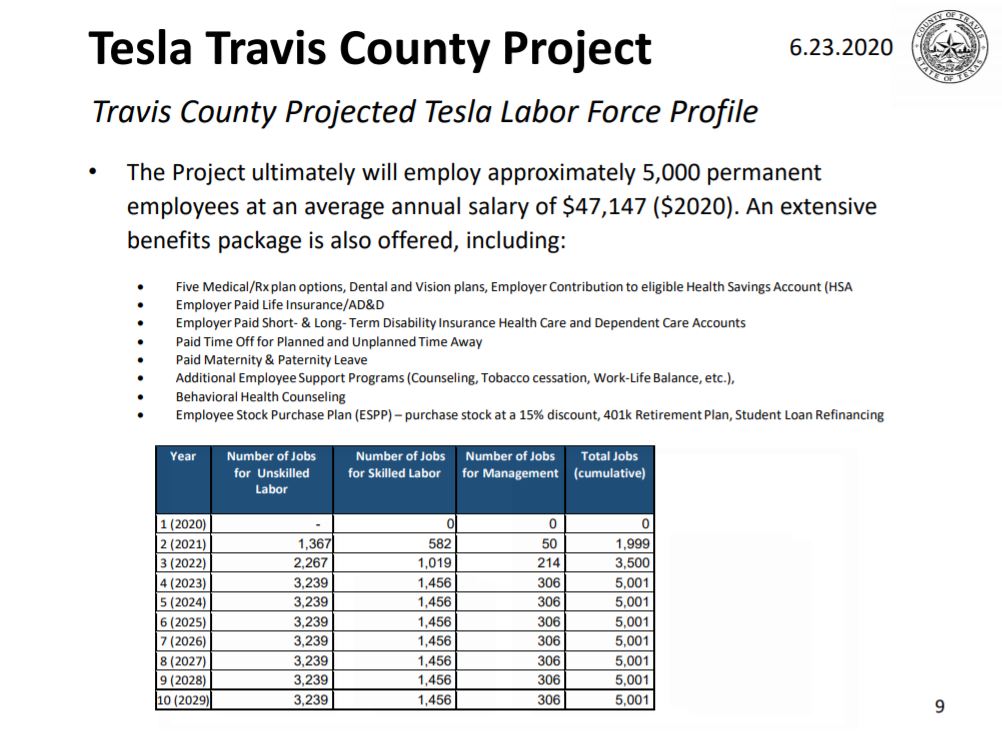
Manuel Quinto-Pozos, representing the UAW and himself as an employment lawyer, agreed with Wolff’s comments and requested that Tesla expands on its concerns with previously discussed building standards. Jeremy Hendricks, representing local construction labor unions, also requested complete transparency in the onboarding process to ensure minimal pay and safety for workers. On a more negative note, caller Juan Bellman was completely opposed to any incentives being offered by the community. “I wanted to oppose Tesla receiving any economic development incentives,” he said bluntly. “As mentioned, I went to Travis High School and I know that my community does not need a multi-billion [dollar] company coming and receiving those taxes that I know the community needs more than them.”
The Court reconvened on July 8th where the call-in comments were more enthusiastic about the economic prospects from Tesla’s presence.
“I’m calling to urge you to approve this deal and bring Tesla to the region,” rallied executive director Ed Latson of Austin Regional Manufacturers Association (ARMA). “We think it’s an extraordinary opportunity, a political win, a cultural win, and an economic win that we have never seen. This court has the opportunity to bring hundreds of millions of dollars of economic impact to a region that has been neglected economically…[and]…impacted negatively by the current economic conditions and really give them skills and a pathway to the middle class.”
The incentives being discussed are property tax rebates worth around $15 million dollars over the course of ten years. In addition to economic incentives from Travis County, Tesla is pursuing a school tax abatement request with the Del Valle Independent School District which would save the company around $50 million over the same ten year time period. Their application package has been submitted and approved, but the District’s Board has yet to take a vote on the matter. Tesla’s decision on whether to make the Austin area its new home may hinge on gaining these tax approvals and community resistance may also explain CEO Elon Musk’s continued consideration of Tulsa, Oklahoma as an alternative location.
The Travis County Court again postponed a vote on the incentives after the July 8th session, the judge indicating that another discussion would be held on July 14th.

Elon Musk
Elon Musk’s X will start using a Tesla-like software update strategy
The initiative seems designed to accelerate updates to the social media platform, while maintaining maximum transparency.

Elon Musk’s social media platform X will adopt a Tesla-esque approach to software updates for its algorithm.
The initiative seems designed to accelerate updates to the social media platform, while maintaining maximum transparency.
X’s updates to its updates
As per Musk in a post on X, the social media company will be making a new algorithm to determine what organic and advertising posts are recommended to users. These updates would then be repeated every four weeks.
“We will make the new 𝕏 algorithm, including all code used to determine what organic and advertising posts are recommended to users, open source in 7 days. This will be repeated every 4 weeks, with comprehensive developer notes, to help you understand what changed,” Musk wrote in his post.
The initiative somewhat mirrors Tesla’s over-the-air update model, where vehicle software is regularly refined and pushed to users with detailed release notes. This should allow users to better understand the details of X’s every update and foster a healthy feedback loop for the social media platform.
xAI and X
X, formerly Twitter, has been acquired by Elon Musk’s artificial intelligence startup, xAI last year. Since then, xAI has seen a rapid rise in valuation. Following the company’s the company’s upsized $20 billion Series E funding round, estimates now suggest that xAI is worth tens about $230 to $235 billion. That’s several times larger than Tesla when Elon Musk received his controversial 2018 CEO Performance Award.
As per xAI, the Series E funding round attracted a diverse group of investors, including Valor Equity Partners, Stepstone Group, Fidelity Management & Research Company, Qatar Investment Authority, MGX, and Baron Capital Group, among others. Strategic partners NVIDIA and Cisco Investments also continued support for building the world’s largest GPU clusters.
News
Tesla FSD Supervised wins MotorTrend’s Best Driver Assistance Award
The decision marks a notable reversal for the publication from prior years, with judges citing major real-world improvements that pushed Tesla’s latest FSD software ahead of every competing ADAS system.

Tesla’s Full Self-Driving (Supervised) system has been named the best driver-assistance technology on the market, earning top honors at the 2026 MotorTrend Best Tech Awards.
The decision marks a notable reversal for the publication from prior years, with judges citing major real-world improvements that pushed Tesla’s latest FSD software ahead of every competing ADAS system. And it wasn’t even close.
MotorTrend reverses course
MotorTrend awarded Tesla FSD (Supervised) its 2026 Best Tech Driver Assistance title after extensive testing of the latest v14 software. The publication acknowledged that it had previously criticized earlier versions of FSD for erratic behavior and near-miss incidents, ultimately favoring rivals such as GM’s Super Cruise in earlier evaluations.
According to MotorTrend, the newest iteration of FSD resolved many of those shortcomings. Testers said v14 showed far smoother behavior in complex urban scenarios, including unprotected left turns, traffic circles, emergency vehicles, and dense city streets. While the system still requires constant driver supervision, judges concluded that no other advanced driver-assistance system currently matches its breadth of capability.
Unlike rival systems that rely on combinations of cameras, radar, lidar, and mapped highways, Tesla’s FSD operates using a camera-only approach and is capable of driving on city streets, rural roads, and freeways. MotorTrend stated that pure utility, the ability to handle nearly all road types, ultimately separated FSD from competitors like Ford BlueCruise, GM Super Cruise, and BMW’s Highway Assistant.
High cost and high capability
MotorTrend also addressed FSD’s pricing, which remains significantly higher than rival systems. Tesla currently charges $8,000 for a one-time purchase or $99 per month for a subscription, compared with far lower upfront and subscription costs from other automakers. The publication noted that the premium is justified given FSD’s unmatched scope and continuous software evolution.
Safety remained a central focus of the evaluation. While testers reported collision-free operation over thousands of miles, they noted ongoing concerns around FSD’s configurable driving modes, including options that allow aggressive driving and speeds beyond posted limits. MotorTrend emphasized that, like all Level 2 systems, FSD still depends on a fully attentive human driver at all times.
Despite those caveats, the publication concluded that Tesla’s rapid software progress fundamentally reshaped the competitive landscape. For drivers seeking the most capable hands-on driver-assistance system available today, MotorTrend concluded Tesla FSD (Supervised) now stands alone at the top.
News
Elon Musk’s Grokipedia surges to 5.6M articles, almost 79% of English Wikipedia
The explosive growth marks a major milestone for the AI-powered online encyclopedia, which was launched by Elon Musk’s xAI just months ago.

Elon Musk’s Grokipedia has grown to an impressive 5,615,201 articles as of today, closing in on 79% of the English Wikipedia’s current total of 7,119,376 articles.
The explosive growth marks a major milestone for the AI-powered online encyclopedia, which was launched by Elon Musk’s xAI just months ago. Needless to say, it would only be a matter of time before Grokipedia exceeds English Wikipedia in sheer volume.
Grokipedia’s rapid growth
xAI’s vision for Grokipedia emphasizes neutrality, while Grok’s reasoning capabilities allow for fast drafting and fact-checking. When Elon Musk announced the initiative in late September 2025, he noted that Grokipedia would be an improvement to Wikipedia because it would be designed to avoid bias.
At the time, Musk noted that Grokipedia “is a necessary step towards the xAI goal of understanding the Universe.”
Grokipedia was launched in late October, and while xAI was careful to list it only as Version 0.1 at the time, the online encyclopedia immediately earned praise. Wikipedia co-founder Larry Sanger highlighted the project’s innovative approach, noting how it leverages AI to fill knowledge gaps and enable rapid updates. Netizens also observed how Grokipedia tends to present articles in a more objective manner compared to Wikipedia, which is edited by humans.
Elon Musk’s ambitious plans
With 5,615,201 total articles, Grokipedia has now grown to almost 79% of English Wikipedia’s article base. This is incredibly quick, though Grokipedia remains text-only for now. xAI, for its part, has now updated the online encyclopedia’s iteration to v0.2.
Elon Musk has shared bold ideas for Grokipedia, including sending a record of the entire knowledge base to space as part of xAI’s mission to preserve and expand human understanding. At some point, Musk stated that Grokipedia will be renamed to Encyclopedia Galactica, and it will be sent to the cosmos.
“When Grokipedia is good enough (long way to go), we will change the name to Encyclopedia Galactica. It will be an open source distillation of all knowledge, including audio, images and video. Join xAI to help build the sci-fi version of the Library of Alexandria!” Musk wrote, adding in a later post that “Copies will be etched in stone and sent to the Moon, Mars and beyond. This time, it will not be lost.”








